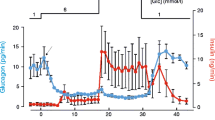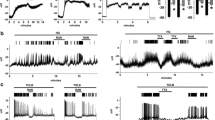Abstract
Potassium channels regulate insulin secretion. The closure of KATP channels leads to membrane depolarisation, which triggers Ca2+ influx and stimulates insulin secretion. The subsequent activation of K+ channels terminates secretion. We examined whether KCNQ1 channels are expressed in pancreatic β-cells and analysed their functional role. Using RT/PCR cellular mRNA of KCNQ1 but not of KCNE1 channels was detected in INS-1 cells. Effects of two sulfonamide analogues, 293B and HMR1556, inhibitors of KCNQ1 channels, were examined on voltage-activated outwardly rectifying K+ currents using the patch-clamp method. It was found that 293B inhibited 60% of whole-cell outward currents induced by voltage pulses from −70 to +50 mV with a concentration for half-maximal inhibition (IC50) of 37 μM. The other sulfonamide analogue HMR1556 inhibited 48% of the outward current with an IC50 of 7 μM. The chromanol 293B had no effect on tolbutamide-sensitive KATP channels. Action potentials induced by current injections were broadened and after-repolarisation was attenuated by 293B. Insulin secretion in the presence but not in the absence of tolbutamide was significantly increased by 293B. These results suggest that 293B- and HMR1556-sensitive channels, probably in concert with other voltage-activated K+ channels, influence action potential duration and frequency and thus insulin secretion.





Similar content being viewed by others
References
Abel KB, Lehr S, Ullrich S (1996) Adrenaline-, not somatostatin-induced hyperpolarization is accompanied by a sustained inhibition of insulin secretion in INS-1 cells. Activation of sulphonylurea KATP channels is not involved. Pflügers Arch 432:89–96
Aguilar-Bryan L, Bryan J (1999) Molecular biology of adenosine triphosphate-sensitive potassium channels. Endocr Rev 20:101–135
Asfari M, Janjic D, Meda P, Li G, Halban PA, Wollheim CB (1992) Establishment of 2-mercaptoethanol-dependent differentiated insulin-secreting cell lines. Endocrinology 130:167–178
Ashcroft FM, Rorsman P (1989) Electrophysiology of the pancreatic β-cell. Prog Biophys Mol Biol 54:87–143
Atwater I, Ribalet B, Rojas E (1979) Mouse pancreatic β-cells: tetraethylammonium blockage of the potassium permeability increase induced by depolarization. J Physiol 288:561–574
Barhanin J, Lesage F, Guillemare E, Fink M, Lazdunski M, Romey G (1996) KvLQT1 and lsK (minK) proteins associate to form the I(Ks) cardiac potassium current. Nature 384:78–80
Bleich M, Briel M, Busch AE, Lang HJ, Gerlach U, Gogelein H, Greger R, Kunzelmann K (1997) KVLQT channels are inhibited by the K+ channel blocker 293B. Pflügers Arch 434:499–501
Bokvist K, Rorsman P, Smith PA (1990) Block of ATP-regulated and Ca2+-activated K+ channels in mouse pancreatic β-cells by external tetraethylammonium and quinine. J Physiol 423:327–342
Bokvist K, Rorsman P, Smith PA (1990) Effects of external tetraethylammonium ions and quinine on delayed rectifying K+ channels in mouse pancreatic β-cells. J Physiol 423:311–325
Bosch RF, Gaspo R, Busch AE, Lang HJ, Li GR, Nattel S (1998) Effects of the chromanol 293B, a selective blocker of the slow, component of the delayed rectifier K+ current, on repolarization in human and guinea pig ventricular myocytes. Cardiovasc Res 38:441–450
Busch AE, Busch GL, Ford E, Suessbrich H, Lang HJ, Greger R, Kunzelmann K, Attali B, Stuhmer W (1997) The role of the IsK protein in the specific pharmacological properties of the IKs channel complex. Br J Pharmacol 122:187–189
Busch AE, Suessbrich H (1997) Role of the IsK protein in the IminK channel complex. Trends Pharmacol Sci 18:26–29
Busch AE, Suessbrich H, Waldegger S, Sailer E, Greger R, Lang H, Lang F, Gibson KJ, Maylie JG (1996) Inhibition of IKs in guinea pig cardiac myocytes and guinea pig IsK channels by the chromanol 293B. Pflügers Arch 432:1094–1096
Chouabe C, Neyroud N, Guicheney P, Lazdunski M, Romey G, Barhanin J (1997) Properties of KvLQT1 K+ channel mutations in Romano-Ward and Jervell and Lange-Nielsen inherited cardiac arrhythmias. EMBO J 16:5472–5479
Diener M, Hug F, Strabel D, Scharrer E (1996) Cyclic AMP-dependent regulation of K+ transport in the rat distal colon. Br J Pharmacol 118:1477–1487
Gerlach U, Brendel J, Lang HJ, Paulus EF, Weidmann K, Bruggemann A, Busch AE, Suessbrich H, Bleich M, Greger R (2001) Synthesis and activity of novel and selective IKs-channel blockers. J Med Chem 44:3831–3837
Greger R, Bleich M, Riedemann N, van Driessche W, Ecke D, Warth R (1997) The role of K+ channels in colonic Cl− secretion. Comp Biochem Physiol A Physiol 118:271–275
Grodsky GM, Epstein GH, Fanska R, Karam JH (1977) Pancreatic action of the sulfonylureas. Fed Proc 36:2714–2719
Kubisch C, Schroeder BC, Friedrich T, Lutjohann B, El Amraoui A, Marlin S, Petit C, Jentsch TJ (1999) KCNQ4, a novel potassium channel expressed in sensory outer hair cells, is mutated in dominant deafness. Cell 96:437–446
Kukuljan M, Goncalves AA, Atwater I (1991) Charybdotoxin-sensitive KCa channel is not involved in glucose-induced electrical activity in pancreatic β-cells. J Membr Biol 119:187–195
Li ZW, Ding JP, Kalyanaraman V, Lingle CJ (1999) RINm5f cells express inactivating BK channels whereas HIT cells express noninactivating BK channels. J Neurophysiol 81:611–624
Loussouarn G, Charpentier F, Mohammad-Panah R, Kunzelmann K, Baro I, Escande D (1997) KvLQT1 potassium channel but not IsK is the molecular target for trans-6-cyano-4-(N-ethylsulfonyl-N-methylamino)-3-hydroxy-2,2-dimethyl-chromane. Mol Pharmacol 52:1131–1136
MacDonald PE, Sewing S, Wang J, Joseph JW, Smukler SR, Sakellaropoulos G, Wang J, Saleh MC, Chan CB, Tsushima RG, Salapatek AM, Wheeler MB (2002) Inhibition of Kv2.1 voltage-dependent K+ channels in pancreatic β-cells enhances glucose-dependent insulin secretion. J Biol Chem 277:44938–44945
MacDonald PE, Wheeler MB (2003) Voltage-dependent K+ channels in pancreatic β cells: role, regulation and potential as therapeutic targets. Diabetologia 46:1046–1062
Philipson LH (1999) β-cell ion channels: keys to endodermal excitability. Horm Metab Res 31:455–461
Philipson LH, Rosenberg MP, Kuznetsov A, Lancaster ME, Worley JF, III, Roe MW, Dukes ID (1994) Delayed rectifier K+ channel overexpression in transgenic islets and β-cells associated with impaired glucose responsiveness. J Biol Chem 269:27787–27790
Roe MW, Worley JF, III, Mittal AA, Kuznetsov A, DasGupta S, Mertz RJ, Witherspoon SM, III, Blair N, Lancaster ME, McIntyre MS, Shehee WR, Dukes ID, Philipson LH (1996) Expression and function of pancreatic β-cell delayed rectifier K+ channels. Role in stimulus-secretion coupling. J Biol Chem 271:32241–32246
Rorsman P, Bokvist K, Ammala C, Arkhammar P, Berggren PO, Larsson O, Wahlander K (1991) Activation by adrenaline of a low-conductance G protein-dependent K+ channel in mouse pancreatic B cells. Nature 349:77–79
Sanguinetti MC, Curran ME, Zou A, Shen J, Spector PS, Atkinson DL, Keating MT (1996) Coassembly of KvLQT1 and minK (IsK) proteins to form cardiac IKs potassium channel. Nature 384:80–83
Sieg A, Su J, Munoz A, Buchenau M, Nakazaki M, Aguilar-Bryan L, Bryan J, Ullrich S (2004) Epinephrine-induced hyperpolarization of islet cells without KATP channels. Am J Physiol Endocrinol Metab 286:E463–E471
Smith PA, Bokvist K, Rorsman P (1989) Demonstration of A-currents in pancreatic islet cells. Pflügers Arch 413:441–443
Su J, Yu H, Lenka N, Hescheler J, Ullrich S (2001) The expression and regulation of depolarization-activated K+ channels in the insulin-secreting cell line INS-1. Pflügers Arch 442:49–56
Tinel N, Diochot S, Borsotto M, Lazdunski M, Barhanin J (2000) KCNE2 confers background current characteristics to the cardiac KCNQ1 potassium channel. EMBO J 19:6326–6330
Ullrich S, Abel KB, Lehr S, Greger R (1996) Effects of glucose, forskolin and tolbutamide on membrane potential and insulin secretion in the insulin-secreting cell line INS-1. Pflügers Arch 432:630–636
Vozzi C, Ullrich S, Charollais A, Philippe J, Orci L, Meda P (1995) Adequate connexin-mediated coupling is required for proper insulin production. J Cell Biol 131:1561–1572
Wang Q, Curran ME, Splawski I, Burn TC, Millholland JM, VanRaay TJ, Shen J, Timothy KW, Vincent GM, de Jager T, Schwartz PJ, Toubin JA, Moss AJ, Atkinson DL, Landes GM, Connors TD, Keating MT (1996) Positional cloning of a novel potassium channel gene: KvLQT1 mutations cause cardiac arrhythmias. Nat Genet 12:17–23
Wang W, Xia J, Kass RS (1998) MinK-KvLQT1 fusion proteins, evidence for multiple stoichiometries of the assembled IsK channel. J Biol Chem 273:34069–34074
Warth R, Riedemann N, Bleich M, van Driessche W, Busch AE, Greger R (1996) The cAMP-regulated and 293B-inhibited K+ conductance of rat colonic crypt base cells. Pflügers Arch 432:81–88
Wattanasirichaigoon D, Beggs AH (1998) Molecular genetics of long-QT syndrome. Curr Opin Pediatr 10:628–634
Yang IC, Scherz MW, Bahinski A, Bennett PB, Murray KT (2000) Stereoselective interactions of the enantiomers of chromanol 293B with human voltage-gated potassium channels. J Pharmacol Exp Ther 294:955–962
Yang WP, Levesque PC, Little WA, Conder ML, Ramakrishnan P, Neubauer MG, Blanar MA (1998) Functional expression of two KvLQT1-related potassium channels responsible for an inherited idiopathic epilepsy. J Biol Chem 273:19419–19423
Acknowledgements
We would like to thank Carmen Ilgner and Ines Tegtmeier for skilled technical help. The study was supported by the DFG grant UL 140/4-1, the Köln Fortune Program No. 137/1998/Faculty of Medicine, University of Cologne, a Tübingen fortune grant No. 1346-0-0 and a grant of the German Diabetes Society. S.U. was a recipient of a Heisenberg fellowship.
Author information
Authors and Affiliations
Corresponding author
Rights and permissions
About this article
Cite this article
Ullrich, S., Su, J., Ranta, F. et al. Effects of IKs channel inhibitors in insulin-secreting INS-1 cells. Pflugers Arch - Eur J Physiol 451, 428–436 (2005). https://doi.org/10.1007/s00424-005-1479-2
Received:
Accepted:
Published:
Issue Date:
DOI: https://doi.org/10.1007/s00424-005-1479-2




